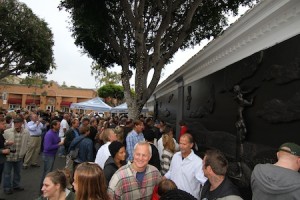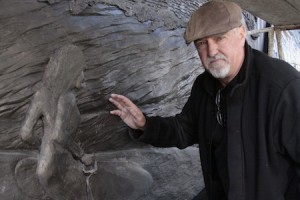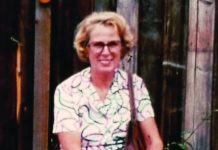
Additions made by sculptor Randy Morgan to his mural titled “A Day in the Life of Laguna,” installed in November on a prominent downtown intersection, were unanimously approved after the fact this past Monday by Laguna Beach’s Arts Commission.
Even so, controversy continues to trail the privately financed bronze relief now commonly referred to as “The Waterman’s Wall” that spans a sidewall of the Hobie store at 294 Forest Ave.
The commission ignored a plea submitted on Feb. 6 by letter from Morgan to add yet another unapproved element to the mural, a plaque listing its supporters, apparently to satisfy a promise by the artist for public recognition to its financial backers.
Morgan, though, did not supply the commission with any supporting sketches or specifications for a plaque, that, according to Section 25.54.024 of the Municipal Code, would have put the mural’s function as a work of art rather than signage into question.
“A plaque is not an art element unless it only identifies the artist, title of the work and its owner,” said the city’s cultural arts manager Sian Poeschl.
Morgan’s pledge to financial donors for recognition in perpetuity seems unlikely to be fulfilled as the commission does not plan to reopen

the issue, Poeschl said.
“I warned him that a plaque constituted signage and could not be considered part of the project package,” said Roger Butow, a local environmental consultant, whose work with Morgan on the project between April and October of 2011 ended in enmity and an apparent financial dispute.
Butow, who did not attend this week’s hearing, called for an inquiry last month, claiming arts commissioners were “duped” by approving work that differs from what was installed, which he claims constitutes an unfair billboard.
Arts commissioners found otherwise when approving the original work in 2010 and this week did not revisit Butow’s allegation over whether the mural’s imagery served as brand iconography.
Revisions to the originally conceived and approved mural include the addition of paddle boarders, more lifeguards, pelicans, a surfer, a Hobie sailboat bearing the letter H and a sculpture of tandem surfers that protrude further from the mural than originally approved.
“I am not so much concerned about a plaque but more about a documentary film that they promised would include my business in,” said Steve Smith, who owns the Taco Bell franchise in Laguna Beach. “The film was to cover the ’70’s beach scene from Main Beach on up and coincide with Taco Bell’s 50th anniversary and 45 years at our location,” he said.
Morgan told Smith that a minimum donation of $2,500 would earn a spot on the plaque and inclusion in the documentary that has yet to be started. “We donate to charity and don’t expect anything in return but I did want to raise awareness of our business,” said Smith.
Most figures in the mural are modeled on locals associated with surfing, sailing, paddle boarding and film making such as pro-surfers Alisa Schwarzstein-Cairns and husband Ian, surfboard maker Hobie Alter and Jim Freeman of MacGillivray-Freeman Films. “The mural is a brilliant idea, it celebrates the camaraderie of the beach,” said Cairns.
Also at issue on Monday was the mural’s longevity due to cracks emerging at joint lines and protruding elements, such as a surfboard, that bulges farther than the approved five inches, which could pose a public danger.
Even though the project is privately owned and financed and on private property, the commission considered whether the city might be held liable in case of injury from a mural element.
Morgan said he had fixed the cracks but promised to re-enforce trouble spots and lower the surfboard’s profile. He defended the wall’s sturdiness saying, “it’s been installed by drilling and screwing, with plenty of mortar in the back. Nothing is going to bring that thing down.”
Rendered in a bas relief style, the mural measures 19’8” in length, 10’5 in height and five inches in approved depth. It is fabricated of resin and bronze powder.
“I do not want anyone to believe that I am happy with the mural,” said Commissioner Ken Auster, who pointed out he had no role in its approval. “When I first saw the sketches they were generalizations of the human figure without specific features. I find the patronage of water sports admirable but the execution is amateurish,” he said.
Even so, he said, “the last thing I want to see is Randy on the side of the street with a hammer, chisel and grinder. We should let all the changes stand. It is what it is.”





[…] artist Randy Morgan, the creator of the bronze mural on the downtown Hobie store, “The Waterman’s Wall,” conceived the idea of a monument to Carrillo after running into him at local eatery one […]